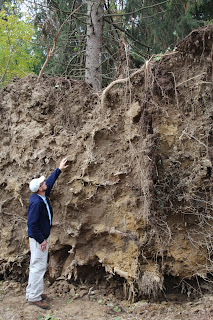 |
| The root ball of a Norway spruce uprooted by Hurricane Sandy |
The eye of the storm passed about 40 miles south of the preserve, but the winds howled all Monday night. We lost electricity for 2-1/2 days and, since we're on a well, we also had no water. Nor did we have any heat. Fortunately, none of the built infrastructure at the preserve was damaged, but the forests took a real beating.
 |
| Just one of over 100 mature trees toppled or snapped by Sandy |
But the forests of the preserve (and most natural areas on the East Coast), are small, fragmented, and full of invasive plants. Instead of new trees filling these light gaps, porcelain-berry (Ampelopsis brevipedunculata), Asian bittersweet (Celastrus orbiculatus), mulitflora rose (Rosa multiflora), and a host of other non-native species quickly occupy sunny gaps and stymie forest regeneration. We're going to have to be very diligent about replanting the 100+ openings created by the storm to prevent such a scenario.
 |
| Estimating the age of a topped red oak (about 125 years). The blue stains are of unknown origin but were present in the trunk when we cut it. |
(And, on a personal note, I caught my right pinky between two large slabs of the oak's trunk as we rolled them out of the way. Boy, did that hurt, and my finger swelled up, got black-and-blue, and bled a bit, but it wasn't broken.)
 |
| The trunk, limbs and slash from the cut oak |


8 comments:
Ouch! It's a shame to lose a big oak like that one. Did you find any reason why it came down? Was the tree leaning or the wood rotten inside? Top heavy?
It is interesting to see the damage from a natural preserve perspective. Reminds me of the discussions we have about western forests, fire prevention and the cost to the forest with understory overgrowth and fuel build up. There is something to be said for big storms and the natural succession of things.
It'll be interesting to see over time what will grow, and I do appreciate the efforts to keep the non-native invasive species down.
On a side note, thank you for the ID on that assassin bug. That explains why I couldn't find a pic of it on bugguide, when I was searching page after page of long-horn beetles!
Hope your pinky heals well.
HI SCOTT, oh my, and so your landscape is forever changed as well. You have a huge and important endeavor before you. I send you prayers and hope for a rebuild that is beautiful and natural. Be safe, keep your finger wrapped and stay strong, as are we. And a nor'easter is headed straight for us in Connecticut on Wednesday evening into Thursday. God help us all.
Love Gail
peace....
I'm glad you and Kali came through the storm OK, Scott, but it's heartbreaking to see the damage your preserve incurred, even if it is a natural occurrence. I'm fascinated by the blue stains in that tree trunk; let us know if you uncover the source.
Hi, Scott,
Wow, that first picture is amazing.
It’s always sad to see big trees come down. Good luck with your replantings. The blue stain is curious; will you be able to determine what it is? A fungus, maybe?
Sorry about your finger but glad you and Kali made it through the storm.
Jain
Carolyn: The big, old oak that my staff and I dismembered is located in a portion of the preserve that has a high water table. I suspect that the tree was relatively shallowly-rooted, which contributed to its uprooting. The tree itself looked to be perfectly sound--no evidence of rot or damage. Uprooted trees were concentrated in this section of the natural area, which further contributed to my assessment of the effect of the high groundwater levels.
Robin Andrea and Gail: Thanks for your thoughts about my pinky. It's still stiff-ish, a bit swollen, and slightly tinged with black-and-blue. You know, this morning, my pinky got me thinking about thumbscrews--that ancient torture device. Based on the little bit of discomfort that I've experienced, I'd be screaming for mercy with a thumbscrew.
Packrat and Jain: My staff and I surmised that the blue stain was related to a fungal infection, but the blue was located well inside the trunk (not near the bark) and the wood around the staining was sound. I'm going to consult a forester I know to see if he can shed any light on this mystery.
Post a Comment